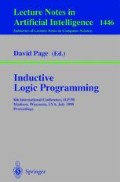Abstract
This paper presents an experimental comparison of two Inductive Logic Programming algorithms, PROGOL and TILDE, with C4.5, a propositional learning algorithm, on a propositional dataset of road traffic accidents. Rebalancing methods are described for handling the skewed distribution of positive and negative examples in this dataset, and the relative cost of errors of commission and omission in this domain. It is noted that before the use of these methods all algorithms perform worse than majority class. On rebalancing, all did significantly better. The conclusion drawn from the experimental results is that on such a propositional dataset ILP algorithms perform competitively in terms of predictive accuracy with propositional systems, but are significantly outperformed in terms of time taken for learning.
Preview
Unable to display preview. Download preview PDF.
References
R. Agrawal, H. Mannila, R. Srikant, H. Toivonen, and A.I. Verkamo. Fast discovery of association rules. In Advances in Knowledge Discovery and Data Mining, pages 307–328. MIT Press, 1996.
H. Blockeel and L. De Raedt. Lookahead and discretization in ILP. In Proceedings of the 7th International Workshop on Inductive Logic Programming, volume 1297 of Lecture Notes in Artificial Intelligence, pages 77–85. Springer-Verlag, 1997.
H. Blockeel and L. De Raedt. Top-down induction of first order logical decision trees. Submitted, 1998.
P. Clark and R. Boswell. Rule induction with CN2: Some recent improvements. In Yves Kodratoff, editor, Proceedings of the 5th European Working Session on Learning, volume 482 of Lecture Notes in Artificial Intelligence, pages 151–163. Springer-Verlag, 1991.
P. Clark and T. Niblett. The CN2 algorithm. Machine Learning, 3(4):261–284, 1989.
J. Cussens, D. Page, S. Muggleton, and A. Srinivasan. Using Inductive Logic Programming for Natural Logic Processing. In W. Daelemans, T. Weijters, and A. van der Bosch, editors, ECML'97-Workshop Notes on Empirical Learning of Natural Language Tasks, pages 25–34, Prague, 1997. University of Economics. Invited keynote paper.
L. Dehaspe and L. De Raedt. Mining association rules in multiple relations. In Proceedings of the 7th International Workshop on Inductive Logic Programming, volume 1297 of Lecture Notes in Artificial Intelligence, pages 125–132. Springer-Verlag, 1997.
B. Dolsak and S. Muggleton. The application of Inductive Logic Programming to finite element mesh design. In S. Muggleton, editor, Inductive Logic Programming, pages 453–472. Academic Press, London, 1992.
R.S. Michalski. A theory and methodology of inductive learning. In Machine Learning: an artificial intelligence approach, volume 1. Morgan Kaufmann, 1983.
S. Muggleton. Inductive logic programming. New Generation Computing, 8(4):295–318, 1991.
S. Muggleton. Inverse entailment and Progol. New Generation Computing, 13:245–286, 1995.
J.R. Quinlan. Induction of decision trees. Machine Learning, 1(1):81–106, 1986.
J.R. Quinlan. C4.5: Programs for Machine Learning. Morgan Kaufmann, 1993. Morgan Kaufmann series in machine learning.
L. De Raedt. Induction in logic. In R.S. Michalski and J. Wnek, editors, Proceedings of the 3rd International Workshop on Multistrategy Learning, pages 29–38, 1996.
L. De Raedt and S. Džeroski. First order jk-clausal theories are PAC-learnable. Artificial Intelligence, 70:375–392, 1994.
A. Srinivasan, S. Muggleton, R. King, and M. Sternberg. Theories for mutagenicity: a study of first-order and feature based induction. Artificial Intelligence, 85(1,2):277–299, 1996.
B. Williams, S. Roberts, and S. Muggleton. Use of ILP to investigate accident data: final report. Technical Report JA022D010-0.1, Smith System Engineering, Surrey Research Park, Guildford, Surrey GU2 5YP, September 1997.
Author information
Authors and Affiliations
Corresponding author
Editor information
Rights and permissions
Copyright information
© 1998 Springer-Verlag Berlin Heidelberg
About this paper
Cite this paper
Roberts, S., vanLaer, W., Jacobs, N., Muggleton, S., Broughton, J. (1998). A comparison of ILP and propositional systems on propositional traffic data. In: Page, D. (eds) Inductive Logic Programming. ILP 1998. Lecture Notes in Computer Science, vol 1446. Springer, Berlin, Heidelberg. https://doi.org/10.1007/BFb0027333
Download citation
DOI: https://doi.org/10.1007/BFb0027333
Published:
Publisher Name: Springer, Berlin, Heidelberg
Print ISBN: 978-3-540-64738-6
Online ISBN: 978-3-540-69059-7
eBook Packages: Springer Book Archive

